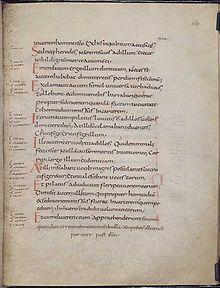Carolingian Renaissance
8th-9th century renaissance within the Carolingian Empire / From Wikipedia, the free encyclopedia
Dear Wikiwand AI, let's keep it short by simply answering these key questions:
Can you list the top facts and stats about Carolingian Renaissance?
Summarize this article for a 10 years old
The Carolingian Renaissance was the first of three medieval renaissances, a period of cultural activity in the Carolingian Empire. It occurred from the late 8th century to the 9th century, taking inspiration from "ancient Roman and Greek culture"[1] and the Christian Roman Empire of the fourth century. During this period, there was an increase of literature, writing, visual arts, architecture, music, jurisprudence, liturgical reforms, and scriptural studies.

The movement occurred mostly during the reigns of Carolingian rulers Charlemagne and Louis the Pious. It was supported by the scholars of the Carolingian court, notably Alcuin of York.[2] Charlemagne's Admonitio generalis (789) and Epistola de litteris colendis served as manifestos.
The effects of this cultural revival were mostly limited to a small group of court literati.[1] According to John Contreni, "it had a spectacular effect on education and culture in Francia, a debatable effect on artistic endeavors, and an unmeasurable effect on what mattered most to the Carolingians, the moral regeneration of society".[3][4] The secular and ecclesiastical leaders of the Carolingian Renaissance made efforts to write better Latin, to copy and preserve patristic and classical texts, and to develop a more legible, classicizing script, with clearly distinct capital and minuscule letters. It was the Carolingian minuscule that Renaissance humanists took to be Roman and employed as humanist minuscule, from which has developed early modern Italic script. They also applied rational ideas to social issues for the first time in centuries, providing a common language and writing style that enabled communication throughout most of Europe.